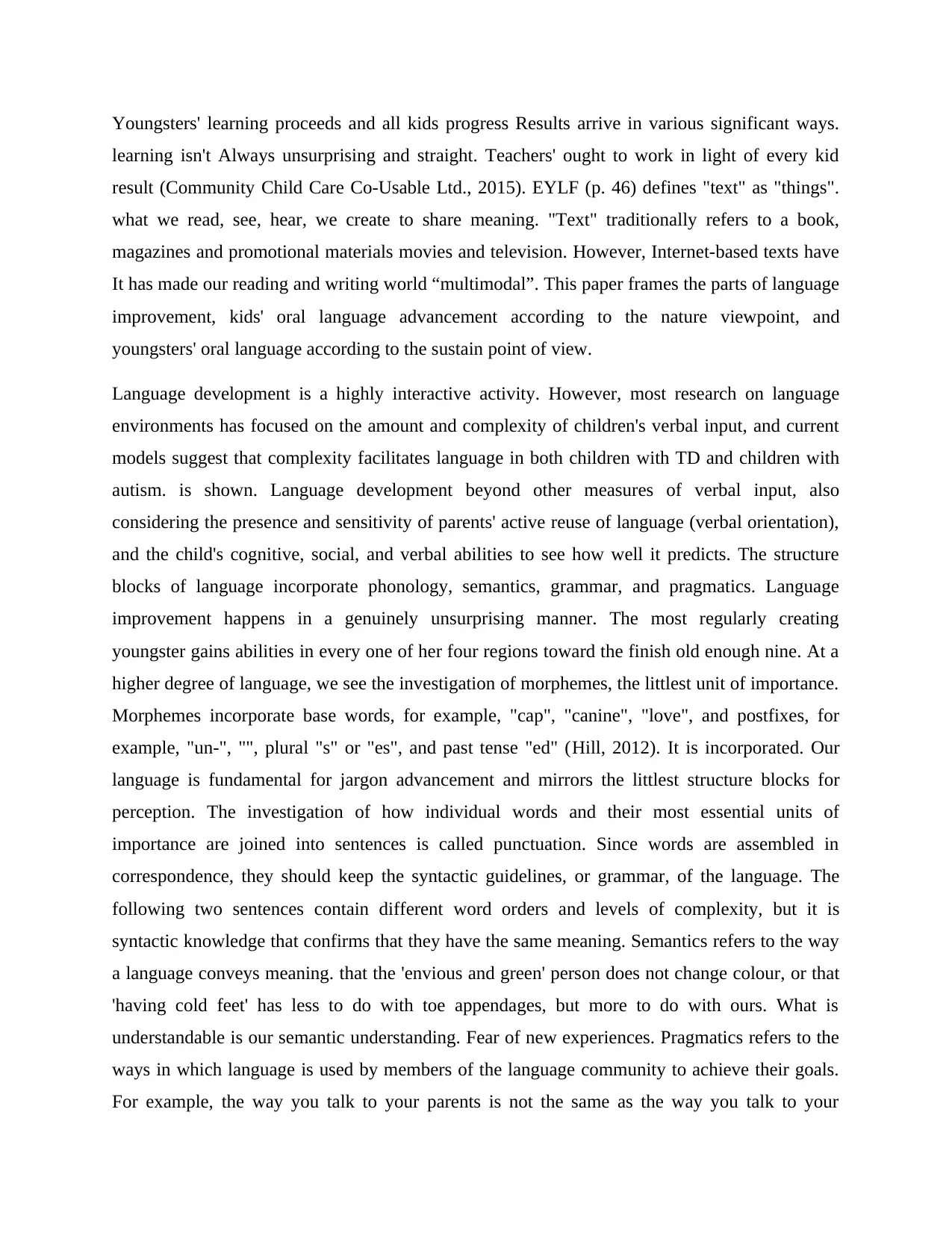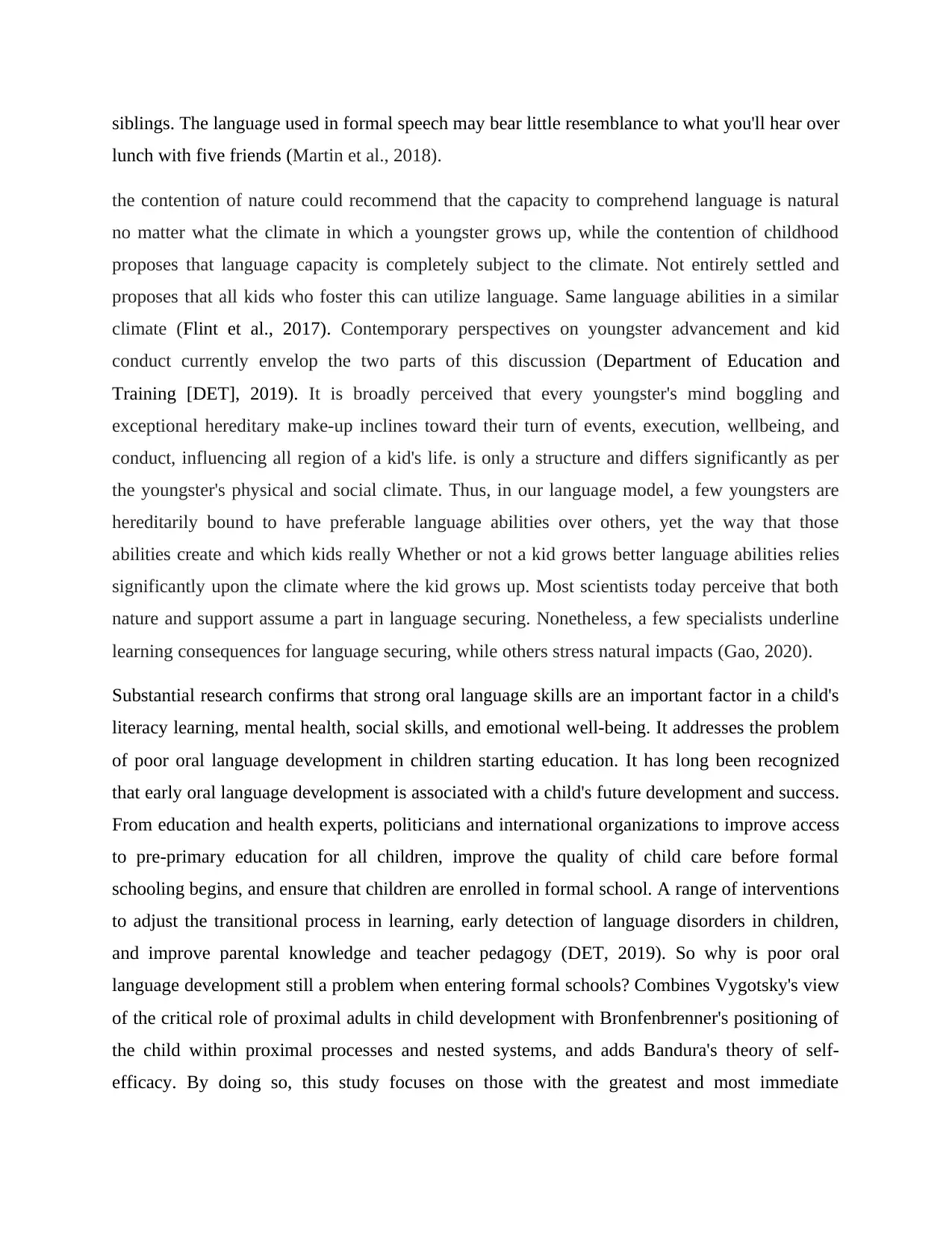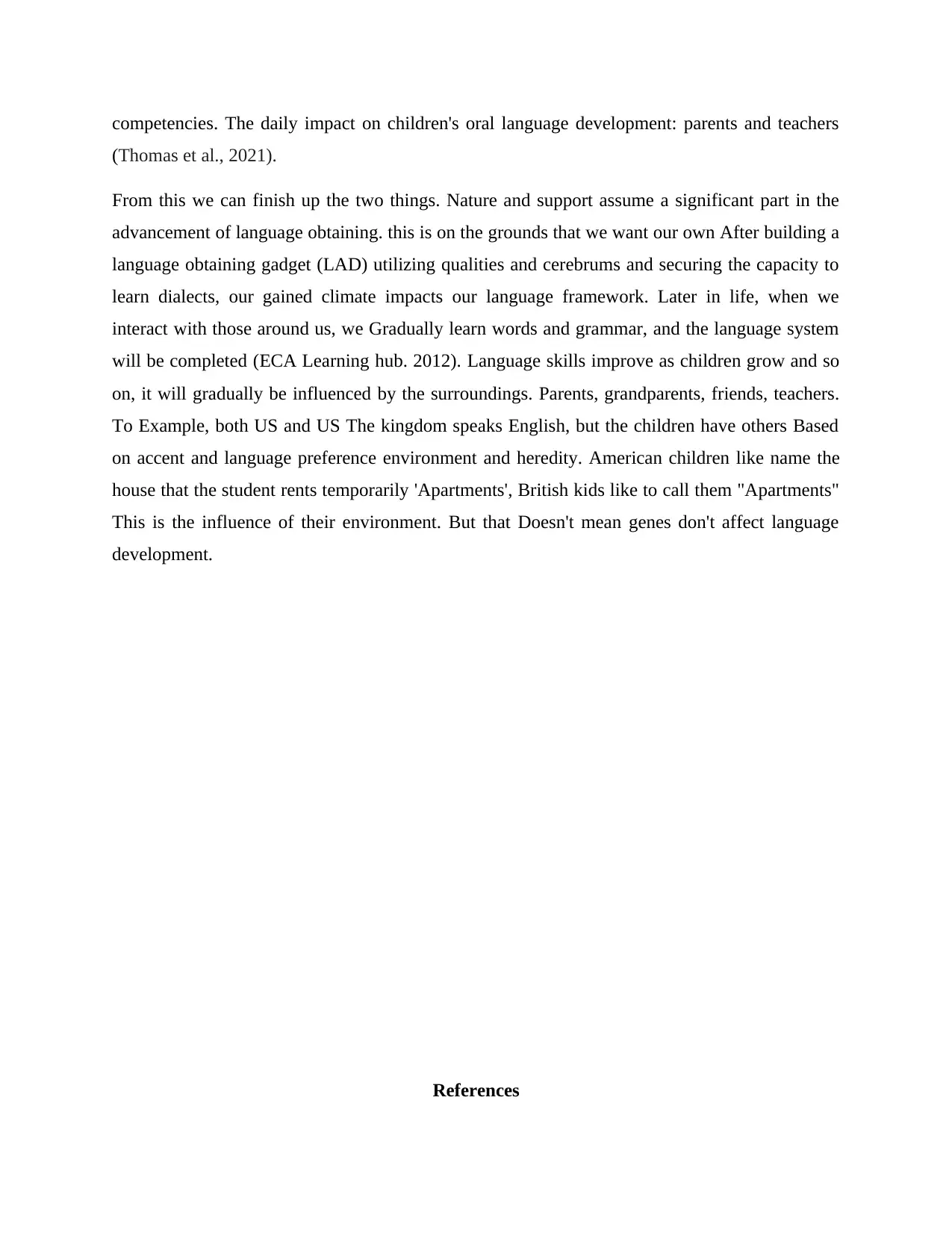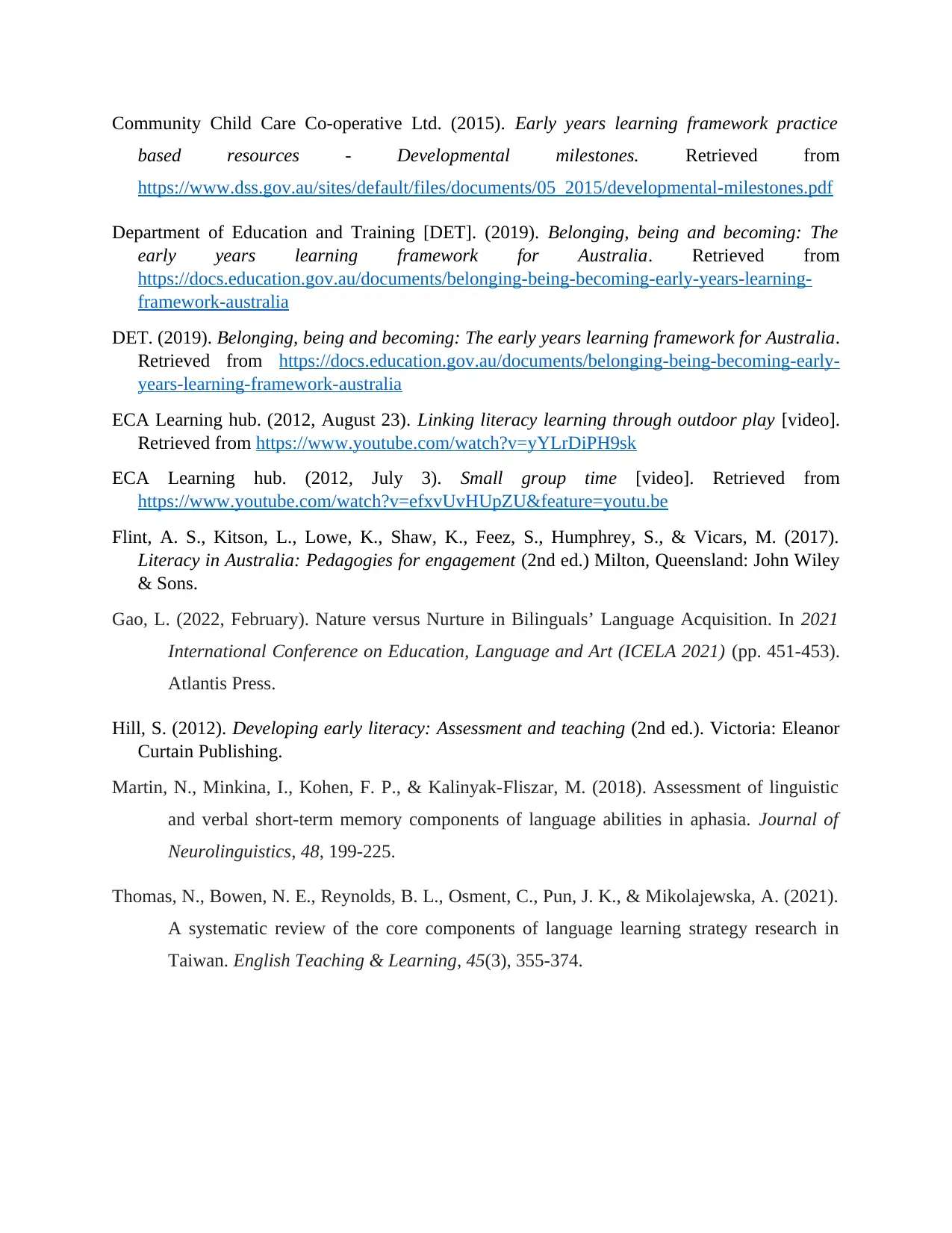Essay: children’s oral language development
VerifiedAdded on 2022/11/22
|5
|1599
|1
Essay
AI Summary
Contribute Materials
Your contribution can guide someone’s learning journey. Share your
documents today.

Essay Report file
Secure Best Marks with AI Grader
Need help grading? Try our AI Grader for instant feedback on your assignments.

Youngsters' learning proceeds and all kids progress Results arrive in various significant ways.
learning isn't Always unsurprising and straight. Teachers' ought to work in light of every kid
result (Community Child Care Co-Usable Ltd., 2015). EYLF (p. 46) defines "text" as "things".
what we read, see, hear, we create to share meaning. "Text" traditionally refers to a book,
magazines and promotional materials movies and television. However, Internet-based texts have
It has made our reading and writing world “multimodal”. This paper frames the parts of language
improvement, kids' oral language advancement according to the nature viewpoint, and
youngsters' oral language according to the sustain point of view.
Language development is a highly interactive activity. However, most research on language
environments has focused on the amount and complexity of children's verbal input, and current
models suggest that complexity facilitates language in both children with TD and children with
autism. is shown. Language development beyond other measures of verbal input, also
considering the presence and sensitivity of parents' active reuse of language (verbal orientation),
and the child's cognitive, social, and verbal abilities to see how well it predicts. The structure
blocks of language incorporate phonology, semantics, grammar, and pragmatics. Language
improvement happens in a genuinely unsurprising manner. The most regularly creating
youngster gains abilities in every one of her four regions toward the finish old enough nine. At a
higher degree of language, we see the investigation of morphemes, the littlest unit of importance.
Morphemes incorporate base words, for example, "cap", "canine", "love", and postfixes, for
example, "un-", "", plural "s" or "es", and past tense "ed" (Hill, 2012). It is incorporated. Our
language is fundamental for jargon advancement and mirrors the littlest structure blocks for
perception. The investigation of how individual words and their most essential units of
importance are joined into sentences is called punctuation. Since words are assembled in
correspondence, they should keep the syntactic guidelines, or grammar, of the language. The
following two sentences contain different word orders and levels of complexity, but it is
syntactic knowledge that confirms that they have the same meaning. Semantics refers to the way
a language conveys meaning. that the 'envious and green' person does not change colour, or that
'having cold feet' has less to do with toe appendages, but more to do with ours. What is
understandable is our semantic understanding. Fear of new experiences. Pragmatics refers to the
ways in which language is used by members of the language community to achieve their goals.
For example, the way you talk to your parents is not the same as the way you talk to your
learning isn't Always unsurprising and straight. Teachers' ought to work in light of every kid
result (Community Child Care Co-Usable Ltd., 2015). EYLF (p. 46) defines "text" as "things".
what we read, see, hear, we create to share meaning. "Text" traditionally refers to a book,
magazines and promotional materials movies and television. However, Internet-based texts have
It has made our reading and writing world “multimodal”. This paper frames the parts of language
improvement, kids' oral language advancement according to the nature viewpoint, and
youngsters' oral language according to the sustain point of view.
Language development is a highly interactive activity. However, most research on language
environments has focused on the amount and complexity of children's verbal input, and current
models suggest that complexity facilitates language in both children with TD and children with
autism. is shown. Language development beyond other measures of verbal input, also
considering the presence and sensitivity of parents' active reuse of language (verbal orientation),
and the child's cognitive, social, and verbal abilities to see how well it predicts. The structure
blocks of language incorporate phonology, semantics, grammar, and pragmatics. Language
improvement happens in a genuinely unsurprising manner. The most regularly creating
youngster gains abilities in every one of her four regions toward the finish old enough nine. At a
higher degree of language, we see the investigation of morphemes, the littlest unit of importance.
Morphemes incorporate base words, for example, "cap", "canine", "love", and postfixes, for
example, "un-", "", plural "s" or "es", and past tense "ed" (Hill, 2012). It is incorporated. Our
language is fundamental for jargon advancement and mirrors the littlest structure blocks for
perception. The investigation of how individual words and their most essential units of
importance are joined into sentences is called punctuation. Since words are assembled in
correspondence, they should keep the syntactic guidelines, or grammar, of the language. The
following two sentences contain different word orders and levels of complexity, but it is
syntactic knowledge that confirms that they have the same meaning. Semantics refers to the way
a language conveys meaning. that the 'envious and green' person does not change colour, or that
'having cold feet' has less to do with toe appendages, but more to do with ours. What is
understandable is our semantic understanding. Fear of new experiences. Pragmatics refers to the
ways in which language is used by members of the language community to achieve their goals.
For example, the way you talk to your parents is not the same as the way you talk to your

siblings. The language used in formal speech may bear little resemblance to what you'll hear over
lunch with five friends (Martin et al., 2018).
the contention of nature could recommend that the capacity to comprehend language is natural
no matter what the climate in which a youngster grows up, while the contention of childhood
proposes that language capacity is completely subject to the climate. Not entirely settled and
proposes that all kids who foster this can utilize language. Same language abilities in a similar
climate (Flint et al., 2017). Contemporary perspectives on youngster advancement and kid
conduct currently envelop the two parts of this discussion (Department of Education and
Training [DET], 2019). It is broadly perceived that every youngster's mind boggling and
exceptional hereditary make-up inclines toward their turn of events, execution, wellbeing, and
conduct, influencing all region of a kid's life. is only a structure and differs significantly as per
the youngster's physical and social climate. Thus, in our language model, a few youngsters are
hereditarily bound to have preferable language abilities over others, yet the way that those
abilities create and which kids really Whether or not a kid grows better language abilities relies
significantly upon the climate where the kid grows up. Most scientists today perceive that both
nature and support assume a part in language securing. Nonetheless, a few specialists underline
learning consequences for language securing, while others stress natural impacts (Gao, 2020).
Substantial research confirms that strong oral language skills are an important factor in a child's
literacy learning, mental health, social skills, and emotional well-being. It addresses the problem
of poor oral language development in children starting education. It has long been recognized
that early oral language development is associated with a child's future development and success.
From education and health experts, politicians and international organizations to improve access
to pre-primary education for all children, improve the quality of child care before formal
schooling begins, and ensure that children are enrolled in formal school. A range of interventions
to adjust the transitional process in learning, early detection of language disorders in children,
and improve parental knowledge and teacher pedagogy (DET, 2019). So why is poor oral
language development still a problem when entering formal schools? Combines Vygotsky's view
of the critical role of proximal adults in child development with Bronfenbrenner's positioning of
the child within proximal processes and nested systems, and adds Bandura's theory of self-
efficacy. By doing so, this study focuses on those with the greatest and most immediate
lunch with five friends (Martin et al., 2018).
the contention of nature could recommend that the capacity to comprehend language is natural
no matter what the climate in which a youngster grows up, while the contention of childhood
proposes that language capacity is completely subject to the climate. Not entirely settled and
proposes that all kids who foster this can utilize language. Same language abilities in a similar
climate (Flint et al., 2017). Contemporary perspectives on youngster advancement and kid
conduct currently envelop the two parts of this discussion (Department of Education and
Training [DET], 2019). It is broadly perceived that every youngster's mind boggling and
exceptional hereditary make-up inclines toward their turn of events, execution, wellbeing, and
conduct, influencing all region of a kid's life. is only a structure and differs significantly as per
the youngster's physical and social climate. Thus, in our language model, a few youngsters are
hereditarily bound to have preferable language abilities over others, yet the way that those
abilities create and which kids really Whether or not a kid grows better language abilities relies
significantly upon the climate where the kid grows up. Most scientists today perceive that both
nature and support assume a part in language securing. Nonetheless, a few specialists underline
learning consequences for language securing, while others stress natural impacts (Gao, 2020).
Substantial research confirms that strong oral language skills are an important factor in a child's
literacy learning, mental health, social skills, and emotional well-being. It addresses the problem
of poor oral language development in children starting education. It has long been recognized
that early oral language development is associated with a child's future development and success.
From education and health experts, politicians and international organizations to improve access
to pre-primary education for all children, improve the quality of child care before formal
schooling begins, and ensure that children are enrolled in formal school. A range of interventions
to adjust the transitional process in learning, early detection of language disorders in children,
and improve parental knowledge and teacher pedagogy (DET, 2019). So why is poor oral
language development still a problem when entering formal schools? Combines Vygotsky's view
of the critical role of proximal adults in child development with Bronfenbrenner's positioning of
the child within proximal processes and nested systems, and adds Bandura's theory of self-
efficacy. By doing so, this study focuses on those with the greatest and most immediate

competencies. The daily impact on children's oral language development: parents and teachers
(Thomas et al., 2021).
From this we can finish up the two things. Nature and support assume a significant part in the
advancement of language obtaining. this is on the grounds that we want our own After building a
language obtaining gadget (LAD) utilizing qualities and cerebrums and securing the capacity to
learn dialects, our gained climate impacts our language framework. Later in life, when we
interact with those around us, we Gradually learn words and grammar, and the language system
will be completed (ECA Learning hub. 2012). Language skills improve as children grow and so
on, it will gradually be influenced by the surroundings. Parents, grandparents, friends, teachers.
To Example, both US and US The kingdom speaks English, but the children have others Based
on accent and language preference environment and heredity. American children like name the
house that the student rents temporarily 'Apartments', British kids like to call them "Apartments"
This is the influence of their environment. But that Doesn't mean genes don't affect language
development.
References
(Thomas et al., 2021).
From this we can finish up the two things. Nature and support assume a significant part in the
advancement of language obtaining. this is on the grounds that we want our own After building a
language obtaining gadget (LAD) utilizing qualities and cerebrums and securing the capacity to
learn dialects, our gained climate impacts our language framework. Later in life, when we
interact with those around us, we Gradually learn words and grammar, and the language system
will be completed (ECA Learning hub. 2012). Language skills improve as children grow and so
on, it will gradually be influenced by the surroundings. Parents, grandparents, friends, teachers.
To Example, both US and US The kingdom speaks English, but the children have others Based
on accent and language preference environment and heredity. American children like name the
house that the student rents temporarily 'Apartments', British kids like to call them "Apartments"
This is the influence of their environment. But that Doesn't mean genes don't affect language
development.
References
Secure Best Marks with AI Grader
Need help grading? Try our AI Grader for instant feedback on your assignments.

Community Child Care Co-operative Ltd. (2015). Early years learning framework practice
based resources - Developmental milestones. Retrieved from
https://www.dss.gov.au/sites/default/files/documents/05_2015/developmental-milestones.pdf
Department of Education and Training [DET]. (2019). Belonging, being and becoming: The
early years learning framework for Australia. Retrieved from
https://docs.education.gov.au/documents/belonging-being-becoming-early-years-learning-
framework-australia
DET. (2019). Belonging, being and becoming: The early years learning framework for Australia.
Retrieved from https://docs.education.gov.au/documents/belonging-being-becoming-early-
years-learning-framework-australia
ECA Learning hub. (2012, August 23). Linking literacy learning through outdoor play [video].
Retrieved from https://www.youtube.com/watch?v=yYLrDiPH9sk
ECA Learning hub. (2012, July 3). Small group time [video]. Retrieved from
https://www.youtube.com/watch?v=efxvUvHUpZU&feature=youtu.be
Flint, A. S., Kitson, L., Lowe, K., Shaw, K., Feez, S., Humphrey, S., & Vicars, M. (2017).
Literacy in Australia: Pedagogies for engagement (2nd ed.) Milton, Queensland: John Wiley
& Sons.
Gao, L. (2022, February). Nature versus Nurture in Bilinguals’ Language Acquisition. In 2021
International Conference on Education, Language and Art (ICELA 2021) (pp. 451-453).
Atlantis Press.
Hill, S. (2012). Developing early literacy: Assessment and teaching (2nd ed.). Victoria: Eleanor
Curtain Publishing.
Martin, N., Minkina, I., Kohen, F. P., & Kalinyak-Fliszar, M. (2018). Assessment of linguistic
and verbal short-term memory components of language abilities in aphasia. Journal of
Neurolinguistics, 48, 199-225.
Thomas, N., Bowen, N. E., Reynolds, B. L., Osment, C., Pun, J. K., & Mikolajewska, A. (2021).
A systematic review of the core components of language learning strategy research in
Taiwan. English Teaching & Learning, 45(3), 355-374.
based resources - Developmental milestones. Retrieved from
https://www.dss.gov.au/sites/default/files/documents/05_2015/developmental-milestones.pdf
Department of Education and Training [DET]. (2019). Belonging, being and becoming: The
early years learning framework for Australia. Retrieved from
https://docs.education.gov.au/documents/belonging-being-becoming-early-years-learning-
framework-australia
DET. (2019). Belonging, being and becoming: The early years learning framework for Australia.
Retrieved from https://docs.education.gov.au/documents/belonging-being-becoming-early-
years-learning-framework-australia
ECA Learning hub. (2012, August 23). Linking literacy learning through outdoor play [video].
Retrieved from https://www.youtube.com/watch?v=yYLrDiPH9sk
ECA Learning hub. (2012, July 3). Small group time [video]. Retrieved from
https://www.youtube.com/watch?v=efxvUvHUpZU&feature=youtu.be
Flint, A. S., Kitson, L., Lowe, K., Shaw, K., Feez, S., Humphrey, S., & Vicars, M. (2017).
Literacy in Australia: Pedagogies for engagement (2nd ed.) Milton, Queensland: John Wiley
& Sons.
Gao, L. (2022, February). Nature versus Nurture in Bilinguals’ Language Acquisition. In 2021
International Conference on Education, Language and Art (ICELA 2021) (pp. 451-453).
Atlantis Press.
Hill, S. (2012). Developing early literacy: Assessment and teaching (2nd ed.). Victoria: Eleanor
Curtain Publishing.
Martin, N., Minkina, I., Kohen, F. P., & Kalinyak-Fliszar, M. (2018). Assessment of linguistic
and verbal short-term memory components of language abilities in aphasia. Journal of
Neurolinguistics, 48, 199-225.
Thomas, N., Bowen, N. E., Reynolds, B. L., Osment, C., Pun, J. K., & Mikolajewska, A. (2021).
A systematic review of the core components of language learning strategy research in
Taiwan. English Teaching & Learning, 45(3), 355-374.
1 out of 5
Your All-in-One AI-Powered Toolkit for Academic Success.
+13062052269
info@desklib.com
Available 24*7 on WhatsApp / Email
![[object Object]](/_next/static/media/star-bottom.7253800d.svg)
Unlock your academic potential
© 2024 | Zucol Services PVT LTD | All rights reserved.
